|
|
Route |
|---|---|
|
|
57.16631°N / 5.06847°W |
|
|
Hiking, Mountaineering |
|
|
Spring, Summer, Fall |
|
|
Most of a day |
|
|
Overview
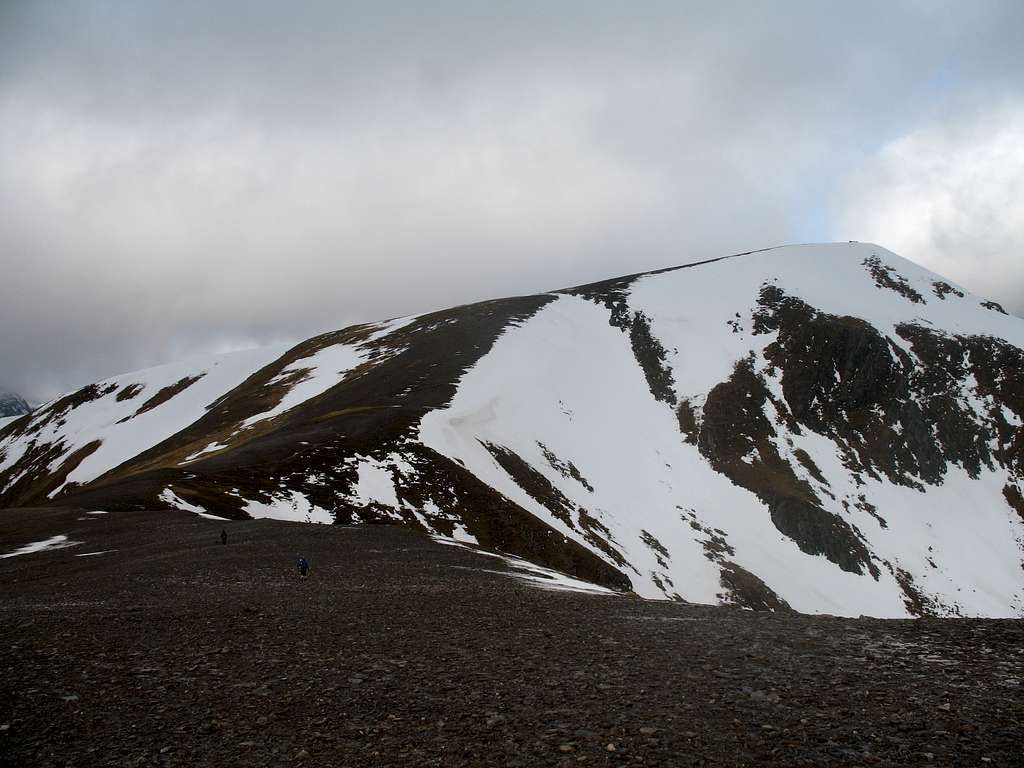
Carn Ghluasaid (957m) - Sgurr nan Conbhairean (1109m) - Sail Chaorainn (1002m)
Carn Ghluasaid, Sgurr nan Conbhairean and Sail Chaorainn are mountains whose summits are hidden from the majority of travellers using the A87 road on the north side of Loch Cluanie. From here, all that is seen are the steep, southern slopes, covered in grass and rocks. However, once some height has been gained, the mountains themselves have many fine characteristics, including the sight of deep and wide corries on their north and eastern sides.
In fact, geographically speaking, the mountains are three summits designated as Munros and four Munro “tops”, all linked by a northward heading, series of grassy ridges. Consequently, this makes them an attractive proposition for an enjoyable ridge traverse in the northwest highlands.
In clear, conditions the traverse should afford great views to the west of nearby A’ Chralaig and Mullach Fraoch – choire (those two mountains can also be taken in on an extended traverse which I’m not going to include in this description), as well as the other Kintail mountains.
Northwards, you are allowed a glimpse into remote Glen Affric and southwards, across Loch Cluanie and the Central Highlands.
There are no technical difficulties on the traverse but it is not to be underestimated, particularly as its position near the Atlantic coast means that the weather is never predictable and any change for the worse can bring serious problems.
It has taken me three attempts over more than 30 years to complete all three mountains on the traverse!
Getting There
By Road:
From Fort William, the A82 and A87 roads head northwards towards Kyle of Lochalsh on the northwest coast.
From Inverness, the A82 road heads south along the shores of Loch Ness. Take the A887 westwards towards Kyle of Lochalsh, where it becomes the A87 at Bunloyne junction.
Carn Ghluasaid lies on the north side of Loch Cluanie, where the A87 road follows the shoreline. Soon after Loch Cluanie is reached travelling west, there is an “S” bend in the road and the shoreline. This is marked as “Lundie” on the map (map reference: 145103) and is now an area for parking (or camping!). If there is no room to park when you arrive, there is another large layby about 100m further west down the road.
Travelling from the west, pass through Glen Shiel and up the valley on the A87 road, passing The Cluanie Inn.
Look out for the parking area at Lundie as described above.
Alternative route start point.
Park alongside the A87 further east than Lundie, near the Ceannacroc bridge (Map ref: 226106) and head north on foot along the private road to the Ceannacroc lodge.
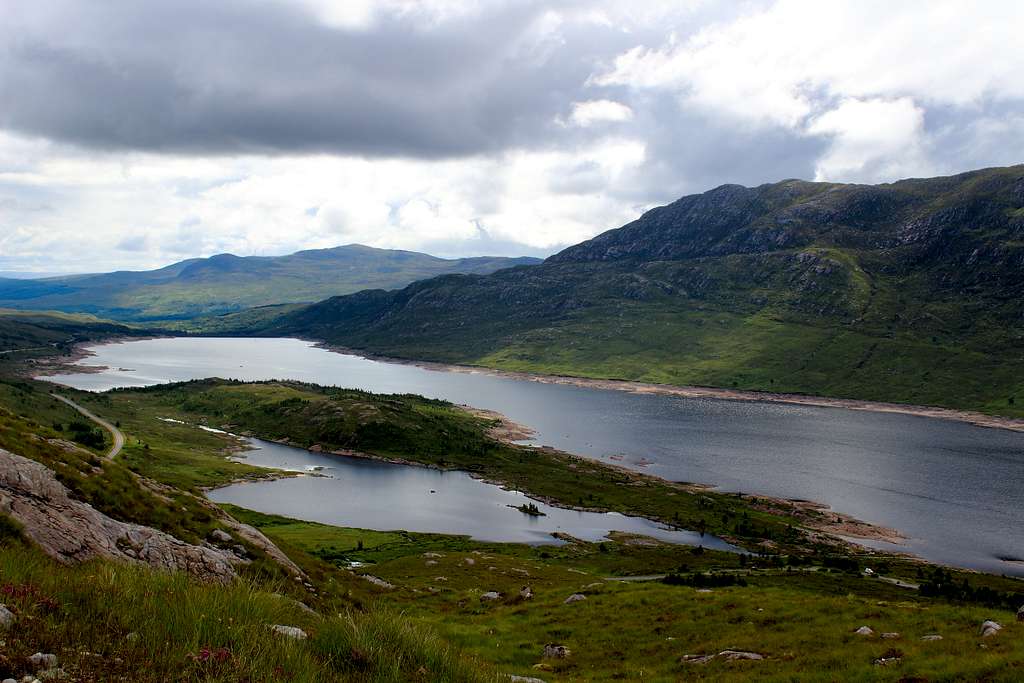
By Bus
Buses are run from Kyle of Lochalsh to Fort William by City Link services.
The nearest bus stop is at Bunloyne junction where the A87 and A887 meet. This would entail a roadside walk westwards of over 7km (4.5 miles) to reach Lundie along the A87. Walk for about 1.5 Km westwards to reach Ceannacroc bridge.
By Rail:
Kyle of Lochalsh is the nearest railway station. Scotrail’s Highland line which runs between Dingwall (north of Inverness) on the east coast and Kyle of Lochalsh on the west coast is the only railway line.
See the Scotrail website for service information:
https://www.scotrail.co.uk/plan-your-journey/stations-and-facilities/ach
Route Description
Three Munros traverse (main route) – Blue route
Traverse extension – Yellow route
Alternative traverse route – Red route
Starting point:
Lundie - There is limited parking in a layby on the A87.
From Lundie, leave the A87 road on the old military road – now a track – which heads west, parallel to the A87.
This track soon passes through a gate and onwards towards a communications aerial. Just after this, a path heads off to the right, uphill (north), take this.
The path is well made and easy to follow, it finds a way up onto An Cruachan, a small hill south of Carn Ghluasaid’s summit.
The path heads a little to the northwest before climbing north up to the rock strewn, southwest rib of the mountain. The path wends its way up this in a northeast direction, until the summit cairn is reached.
The summit cairn of Carn Ghluasaid (957m) the first Munro of the day, is small and most pass by it quickly in favour of the larger cairn about 30m to the northwest which overlooks a large, deep corrie.
Ascent time, around 2 hours.

Continue by following the rim of the large corrie to descend northwest and then by climbing towards Creag a’ Chaorainn – a Munro “top” - and onwards first in a westerly direction over broken, stony ground and then, north up steep route to the large, summit cairn of Sgurr nan Conbhairean (1109m), Munro number two.
This is the highest point of the day and should take about 90 minutes from the summit of Carn Ghluasaid.
Take some time to enjoy the views north and east if possible.
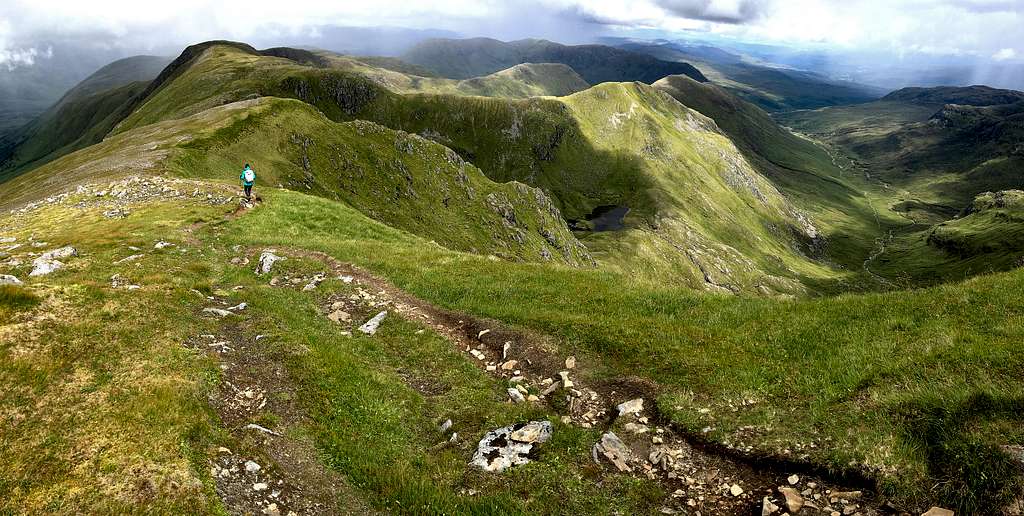
From this summit, descend easily northwards along a path on the grassy ridge. The ridge path descends to a point marked on the map as “914”m. Continue the route by ascending Sail Chaorainn’s south ridge in the same direction.
The ground starts to level out as the ridge from Carn a’ Mhadaidh joins from the east and the small summit cairn of Sail Chaorainn (1002m), Munro number three, is reached about 1 hour after leaving Sgurr nan Conbhairean.
There are extensive views eastwards into the Ceannacroc forest, where the River Doe rises.
Traverse extension
There are two more Munro “tops” further north along the same ridge, that can also be bagged if required, these are Carn na Coire Mheadhoin (1001m) and Tigh Mor na Seilge (929). Follow the feint path along to these two tops. Add about 1 hour onto the route time to return to Sail Chaorainn.
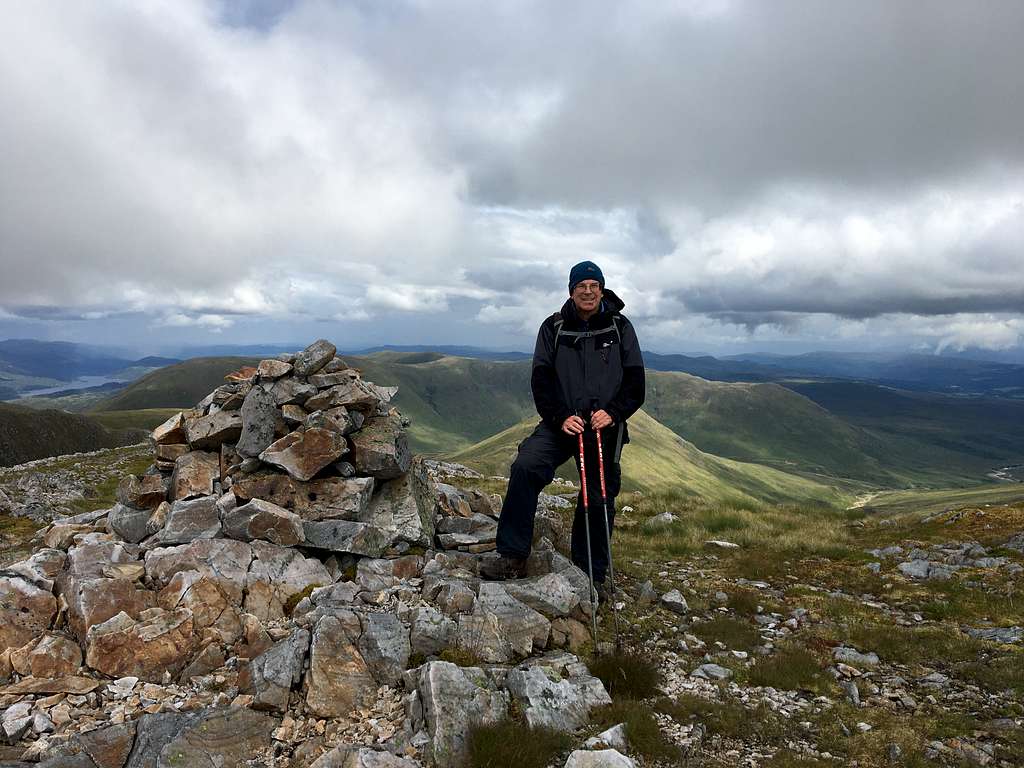
Return to the main traverse
To return southwards from Sail Chaorainn, retrace your steps towards Sgurr nan Conbhairean. There is a descent of around 90m in height to the low point, followed by a re-ascent of about 130m to the northwest shoulder of Sgurr nan Conbhairean.
From here, it is possible to contour around the summit cone of Sgurr nan Conbhairean and return southwards on the ascent route.
However, a more attractive proposition is to head southwest on the grassy ridge to Drochaid an Tuill Easaich (1001m). This is another outlying Munro “top” of Sgurr nan Conbhairean and there is an easy ridge walk to it with fine views of A’ Chraileag beyond. Expect to take about 1 hour to reach here from Sail Chaorainn.
The actual summit of Drochaid an Tuill Easaich can be by-passed on its southern side if required, it has a pleasant, grassy south ridge to walk down as a descent route.
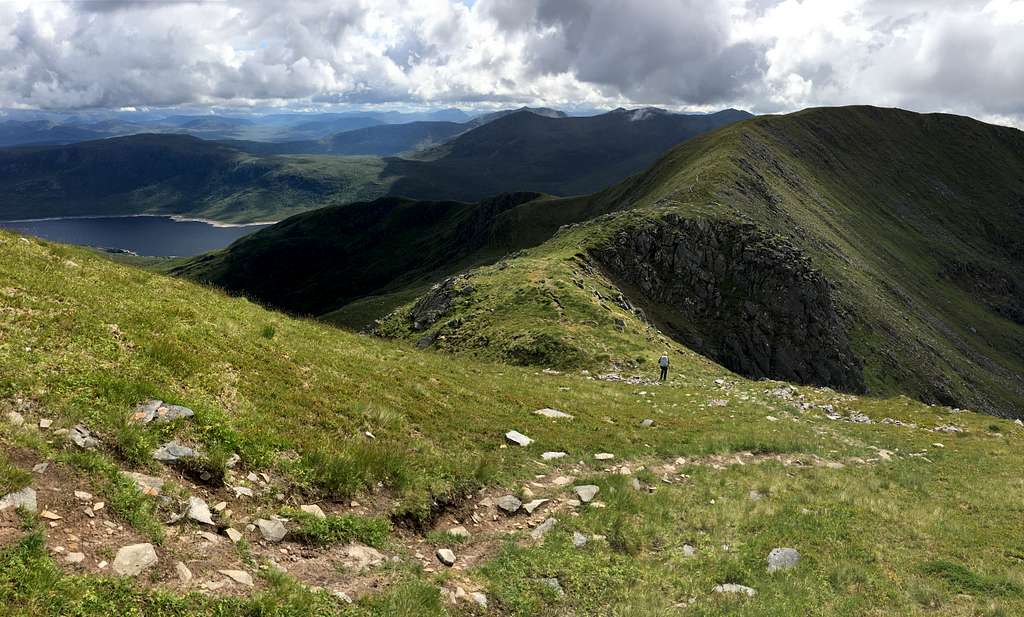
Continue down this ridge with good views back towards the ascent route on Carn Ghluasaid. The path reaches a rocky top called Meall Breac on the map and becomes vague on the descent.
From here, its possible to find a way across the Allt Coire nan Clach on your left then, follow its eastern bank downwards to regain the old military road – a footpath at this point.
Alternatively, continue straight down to cross the same river on steppingstones just beneath a small but attractive waterfall. This should take about 90 mins from the top of Drochaid an Tuill Easaich.
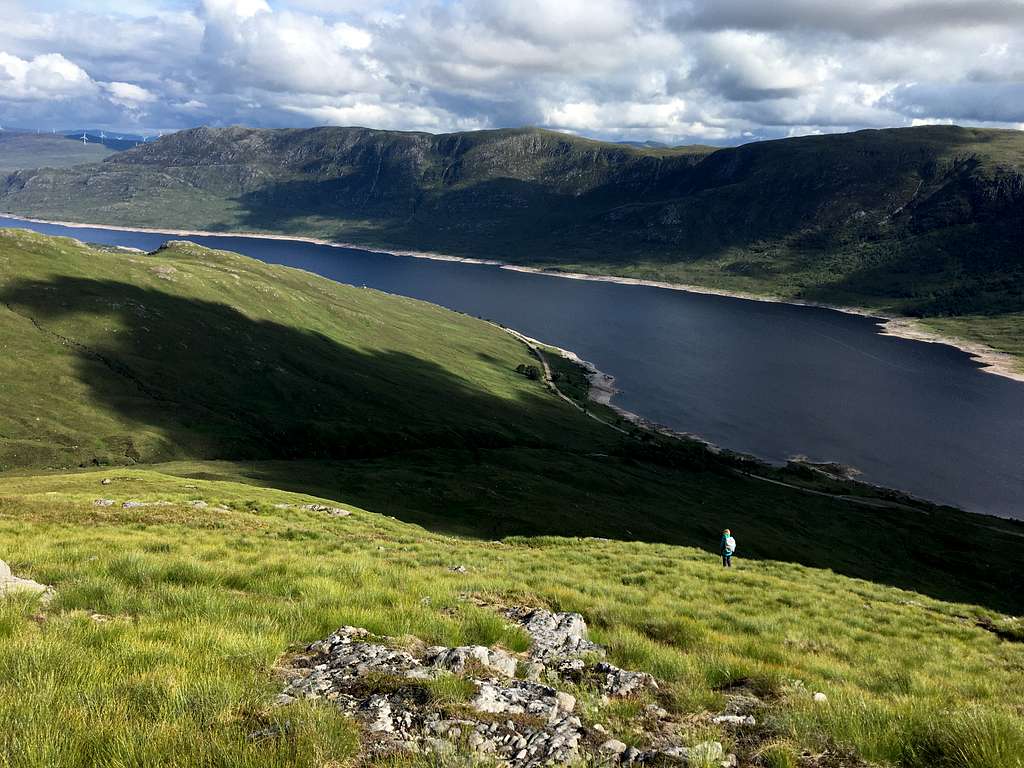
Find the military road/footpath and follow it eastwards towards the communications aerial seen earlier.
From here re-trace your earlier route to the car.
A round trip of 17.5 km which takes approximately 6 – 8 hours depending on how many times you stop to take photos!
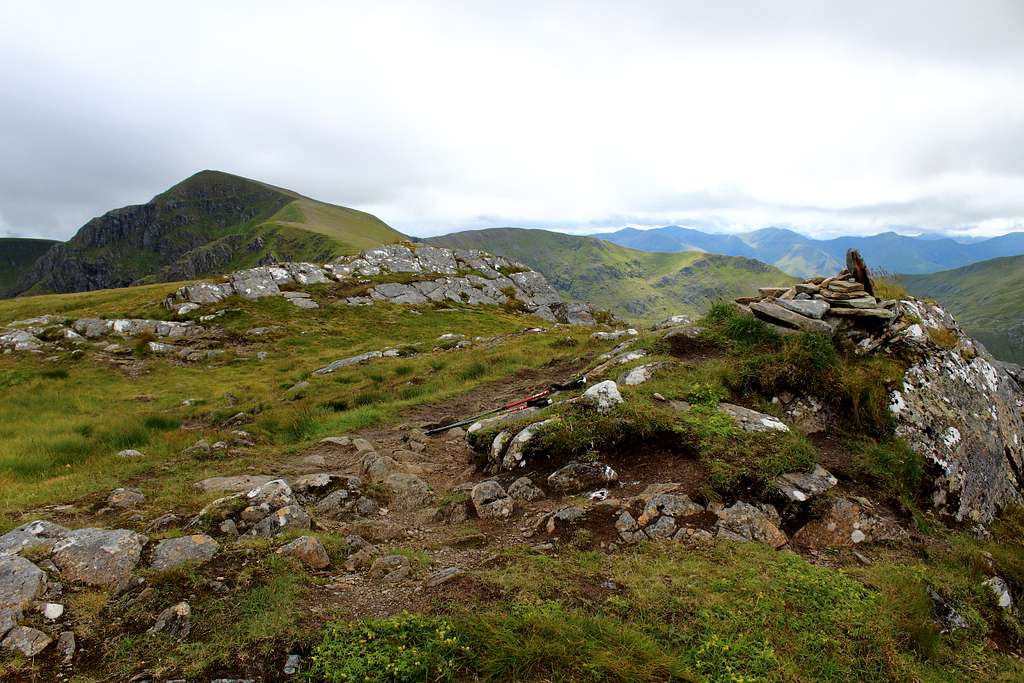
Alternative traverse route.
Starting point:
Park alongside the A87 further east than Lundie, near the Ceannacroc bridge.
The route from Ceannacroc bridge passes the lodge and continues alongside the River Doe on a track, for around 7km to a bridge and a bothy beyond. Pass the bothy and head upwards on the east ridge of An Reithe, pass over its rocky top and descend to a bealach on the ridge.
From here, climb the broken east ridge of Carn a’ Mhadaidh – ruaidh towards Sail Chaorainn, When the main ridge is reached, its summit is northwards along the grass and rock ridge. Ascent time around 4.5 hours.

From Sail Chaorainn, follow the previous route description southwards to climb Sgurr nan Conbhairean to continue.
From this summit and in order to return to your start point, descend in a south easterly direction to reach the summit of Carn Ghluasaid.
From here, descend its east ridge down broken, rocky ground to reach a bealach.
Continue in the same direction, by ascending the ridge of Carn nam Feuaich, beyond this and pass over its rocky top.
Descend over rough, boggy ground towards the track alongside the River Doe and descend down the track towards Ceannacroc lodge. A round trip of 27 km which takes a time of around 9 - 10 hours.
Much of this route is across rough, pathless ground and is a longer and harder route to follow than the other I have described, so care is needed in ascent and especially, in descent. This is not a route I have done or can personally recommend.

When to climb
Spring, Summer or Autumn (Fall) depending on conditions.
Warning: The above descriptions are for use in reasonable summer conditions. Winter conditions can occur at almost any time of the year. In winter condition, these mountains are a much more serious proposition. Any paths may be covered by snow and ice and gale force winds are common.
Ice axe, Crampons, the knowledge of how to use them allied with excellent map reading and compass skills are essential.
The proximity of the west coast and the sea means that mist often forms and can cover the mountains.

Essential Gear
Good walking boots, waterproofs, warm clothing.
Food and water
Map and compass or electronic equivalent
Red tape
Scotland has an Outdoor Access code, see link:
https://www.outdooraccess-scotland.scot/practical-guide-all
The area is popular for Deer stalking and Grouse shooting. These activities may impact on any plans for hiking. However, it is still possible to hike during these events with a little extra effort at the planning stage.
This is a useful page on the Outdoor access – Scotland website
https://www.outdooraccess-scotland.scot/practical-guide-all/heading-scottish-hills

External Links
SMC - https://www.smc.org.uk/
The Munros – (SMC Hillwalkers guidebook)
The High Mountains of Britain and Ireland – I. Butterfield
West Highlands – Nick Williams
Ordnance survey map OS 414 Glen Shiel and Kintail Forest. 1: 25 000

